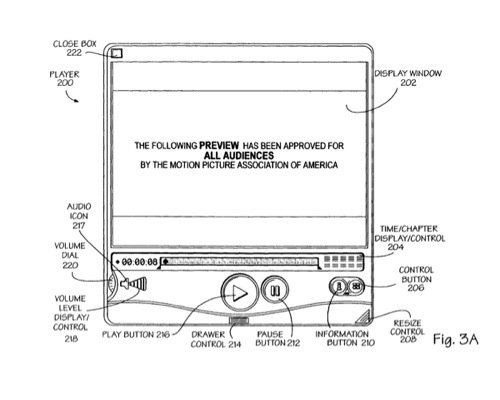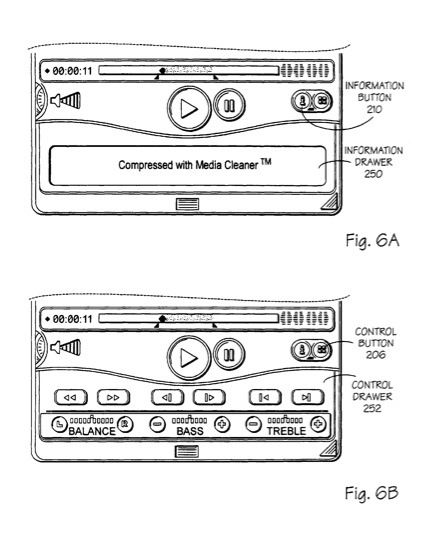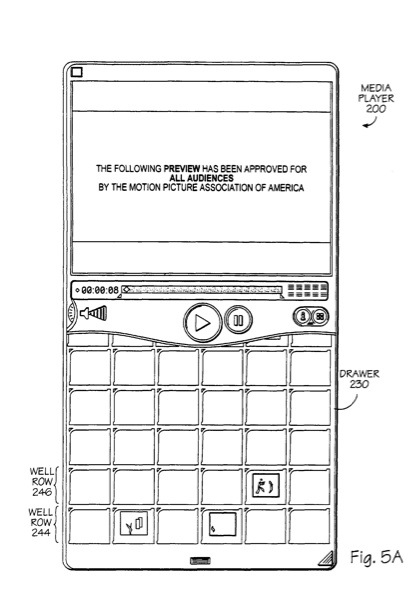The late Steve Jobs is listed as one of the inventors of a patent (number 8196043) for an user interface for presenting media information that's appeared at the U.S. Patent & Trademark Office.
The invention relates to user interfaces for processing (e.g., generating, storing, transmitting and/or receiving, playing back/displaying, editing, referencing, etc.) media information, such as time-based media data representing video and/or audio. In particular, the present invention provides an interactive digital processing system-controlled graphical user interface that provides functionality for play back or other processing of time-based and still media data.
Here's Apple's background and summary of the invention: "In one exemplary method, a graphical representation of a time line for a time-based media is displayed along with a graphical representation of a current time along the graphical representation of the time line. A start graphical indicator and a stop graphical indicator is also displayed along the graphical representation of the time line. A portion of the time-based media may be selected for presentation by dragging or positioning at least one of the start graphical indicator and the stop graphical indicator along the graphical representation of the time line.
"In another aspect of the invention, an exemplary method allows for the adaptive control of a portion of the interface which indicates time relating to a time-based media. An input speed is determined where this input is to change the portion and the rate at which the change to this portion occurs is dependent upon the input speed. Other aspects of the present invention relating to the interface for controlling the processing of time-based media files are also described.
"There are a number of file structures used today to store time-based media: audio formats such as AIFF, video formats such as AVI, and streaming formats such as RealMedia. They are different at least in part because of their different focus and applicability. Some of these formats are sufficiently widely accepted, broad in their application, and relatively easy to implement, that they are used not only for content delivery but also as interchange formats such as the QuickTime.TM. file format. The QuickTime format is used today by many web sites serving time-based data; in many authoring environments, including professional ones; and on many multimedia CD ROM (e.g., DVD or CD-I) titles.
"The QuickTime media layer supports the relatively efficient display and management of general multimedia data, with an emphasis on time-based material (video, audio, video and audio, motion graphics/animation, etc.). The media layer uses the QuickTime file format as the storage and interchange format for media information. The architectural capabilities of the layer are generally broader than the existing implementations, and the file format is capable of representing more information than is currently demanded by the existing QuickTime implementations. Furthermore, the QuickTime file format has structures to represent the temporal behavior of general time-based streams, a concept which covers the time-based emission of network packets, as well as the time-based local presentation of multimedia data.
"Given the capabilities and flexibility provided by time-based media formats, it is desirable to provide a user interface that provides suitable functionality and flexibility for playback and/or other processing of time-based media in such formats.
"Prior user interfaces for controlling the presentation of time-based media include user interfaces for the RealPlayers from RealNetworks of Seattle, Wash., user interfaces for the QuickTime MoviePlayers from Apple Computer, Inc. of Cupertino, Calif., and user interfaces for the Windows Media Players from Microsoft Corporation of Redmond, Wash. Also, there are a number of time-based media authoring systems which allow the media to be created and edited, such as Premiere from Adobe Systems of San Jose, Calif.
"These prior user interfaces typically use 'pop-up' or pull-down menus to display controls (e.g. controls for controlling playback) or to display a list of 'favorites' or 'channels' which are typically predetermined, selected media (e.g. CNN or another broadcast source which is remotely located or a locally stored media source). While these lists or menus may be an acceptable way of presenting this information, the lists or menus may not be easily alterable and the alteration operations are not intuitive. Further, these lists or menus are separate from any window presenting the media and thus do not appear to be part of such window.
"In some prior user interfaces, the various controls are displayed on a border of the same window which presents the media. For example, a time bar may be displayed on a window with controls for playback on the same window. While these controls are readily visible and available to a user, a large number of controls on a window causes the window to appear complex and tends to intimidate a novice user.
"Some prior user interfaces include the ability to select, for presentation, certain chapters or sections of a media. LaserDisc players typically include this capability which may be used when the media is segmented into chapters or sections. A user may be presented with a list of chapters or sections and may select a chapter or section from the list. When this list contains a large number of chapters or sections, the user may scroll through the list but the speed of scrolling is fixed at a single, predetermined rate. Thus, the user's ability to scroll through a list of chapters is limited in these prior user interfaces.
"Certain prior user interfaces which allow for editing of time-based media may include the ability of selecting a range of time of the media for editing in that selected range. However, these interfaces do not allow for the playback, through a single playback button, of a selected range of a media which has been selected by at least one dragging action of an indicator."
The inventors are Daniel N. Crow, Cary Dean, Elizabeth Dykstra-Erickson, J. Peter Hoddie, Steve Jobs and Timothy E. Wasko.















